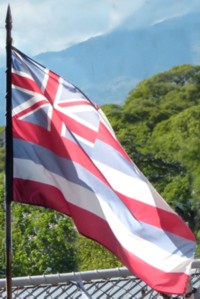Settlement and European Discovery
Like many of the islands in the Pacific, the Sandwich Islands remained uninhabited until the thirteenth century, a full century after William the Conqueror invaded England.
This isn't what most commentators or tourist guide books on Hawaii will tell you. They generally claim that the Polynesians arrived around 600 years earlier. This was based on 19th century, anthropological guesswork and has passed into folk-law.
The later date is the result of modern, more accurate, carbon dating of the first human artefacts. Thus it was around the same time as Polynesians colonised New Zealand.
Genetic ancestry shows that the distant ancestors of the Polynesians migrated from Taiwan to Melanesia about five thousand years ago and then travelled east to the Society Islands. From there they colonised places as far flung as Easter Island and finally set sail, relatively recently, to several as yet uninhabited and probably undiscovered pacific islands, including the Sandwich Islands (Hawaii) and New Zealand. Contrary to another myth they did not come from nor did they inhabit South America.
But this is all academic. It's certainly true that for centuries before first European contact people thrived here and their population grew from one or two small groups of first settlers to several hundred thousand, possibly as many as half a million, islanders. This expansion was sustained by their evolved civil society and social codes and religion; some of these anathema to our present values.
Obviously the Polynesians were able to build ocean-going craft that were sufficiently large or numerous to carry enough people, food, animals and seedlings of staple plants to support viable colonisations. They had mastered navigation and apparently had a belief-system or culture that underwrote such adventurers.
The last to settle Polynesians (for example Hawaiians and Maori) were especially skilled in warfare.
Militarism in Hawaii - Fort DeRussy, US Army Museum - note the implied incorrect time of arrival
Many human cultures encourage young men to prove themselves as warriors, for example New Guinea Highlanders and Australian Aborigines. This requires warlike skirmishes or raids on other groups; and in some cases as in New Guinea highlands full scale battles. Initially anthropologists proposed that from time to time whole groups were expelled to take their chances at sea.
But there is now evidence of trade between far-flung islands that points to return trips, requiring deliberate and highly skilled navigation. Yet their basic technology was Neolithic: stone, bone and wooden tools. Unlike the Vikings or the great Chinese sailors they had no metals and no written language so that knowledge was passed on by word of mouth, from master to apprentice and preserved in drawings and song and dance: Hula - initially a strictly male dance tradition seen only by the initiated. In addition to a complex language, supporting navigational and agricultural skills, the Sandwich Islanders had developed a feudal style hierarchical society in which the upper classes ruled the common people, supported by a complex pantheon of gods and the law of kapu.
Social Structure in the Sandwich Islands - US Army Museum
The first Europeans to visit the islands were led by Captain James Cook, who on an earlier voyage, principally to observe the transit of Venus, first mapped the east coast of Australia. Cook was murdered on the east coast of Hawaii (the big island) as a result of an ill-advised attempt to kidnap the local war-lord in order to recover a stolen longboat and other goods. An obelisk marks the spot to this day. Cook held Polynesians in high regard. He'd discovered that they knew of uncharted islands and could find them by means of currents, bird migration and astronomical observations.
Enforcing kapu - from Hawaiian Journey by Joseph G Mullins
Hawaiians likewise were extraordinarily quick to learn from the new arrivals to their shores. After Cook additional British ships arrived then ships from other European nations stopping to take on water and food in exchange for trade goods, including metal objects and weapons.
Like many Neolithic societies the fundamentals of reproduction were not well understood by the Polynesians. Families were matrilineal as the part men played in childbirth was somewhat obscure. Girls began to have sexual relations after menarche. Abortion and infanticide disposed of unwanted pregnancies and pregnancy and its attendant issues were 'secret women's business'. Thus sexual relations were a normal part of courtship and 'getting to know you' games. To European male sensibilities the young women seemed delightfully promiscuous. This would have disastrous consequences in Hawaii, Tahiti and several other Polynesian communities.

